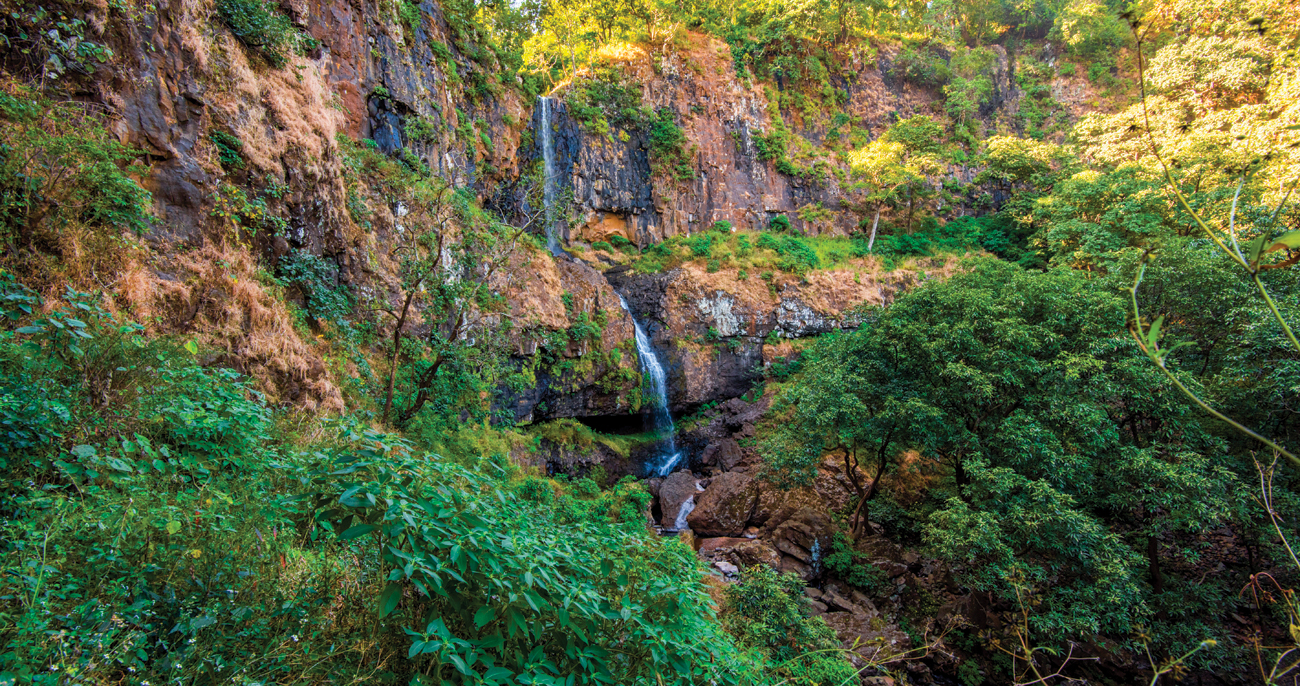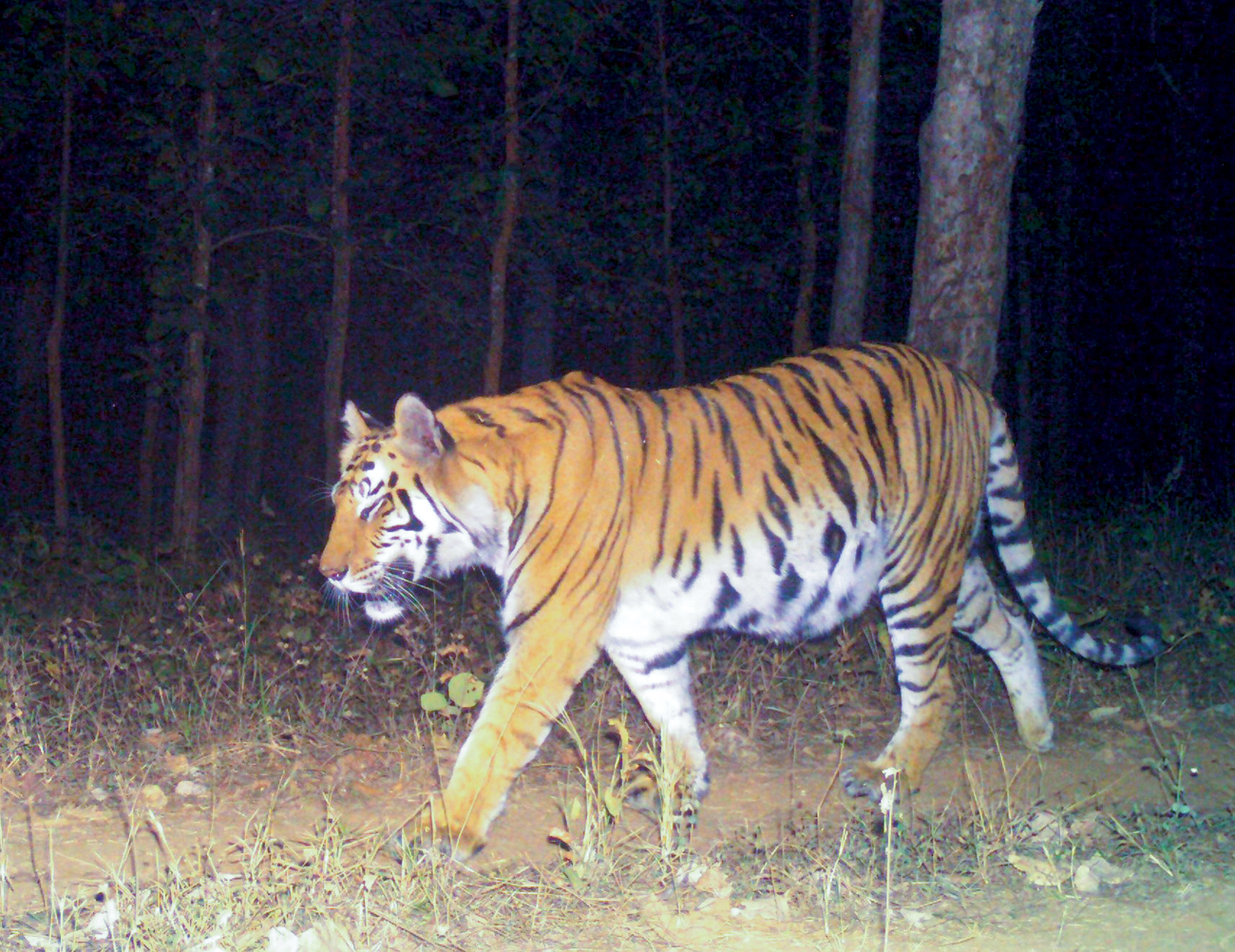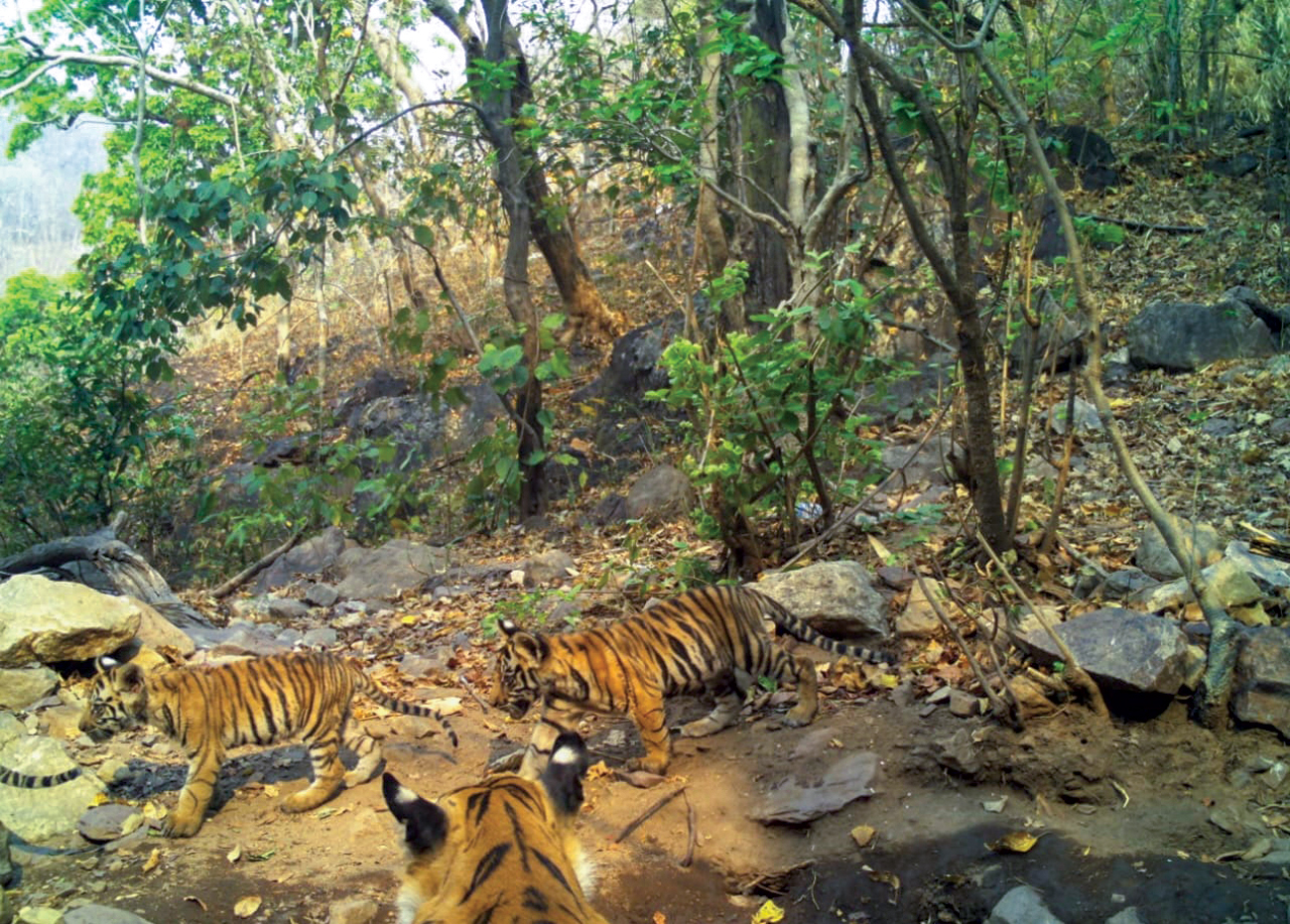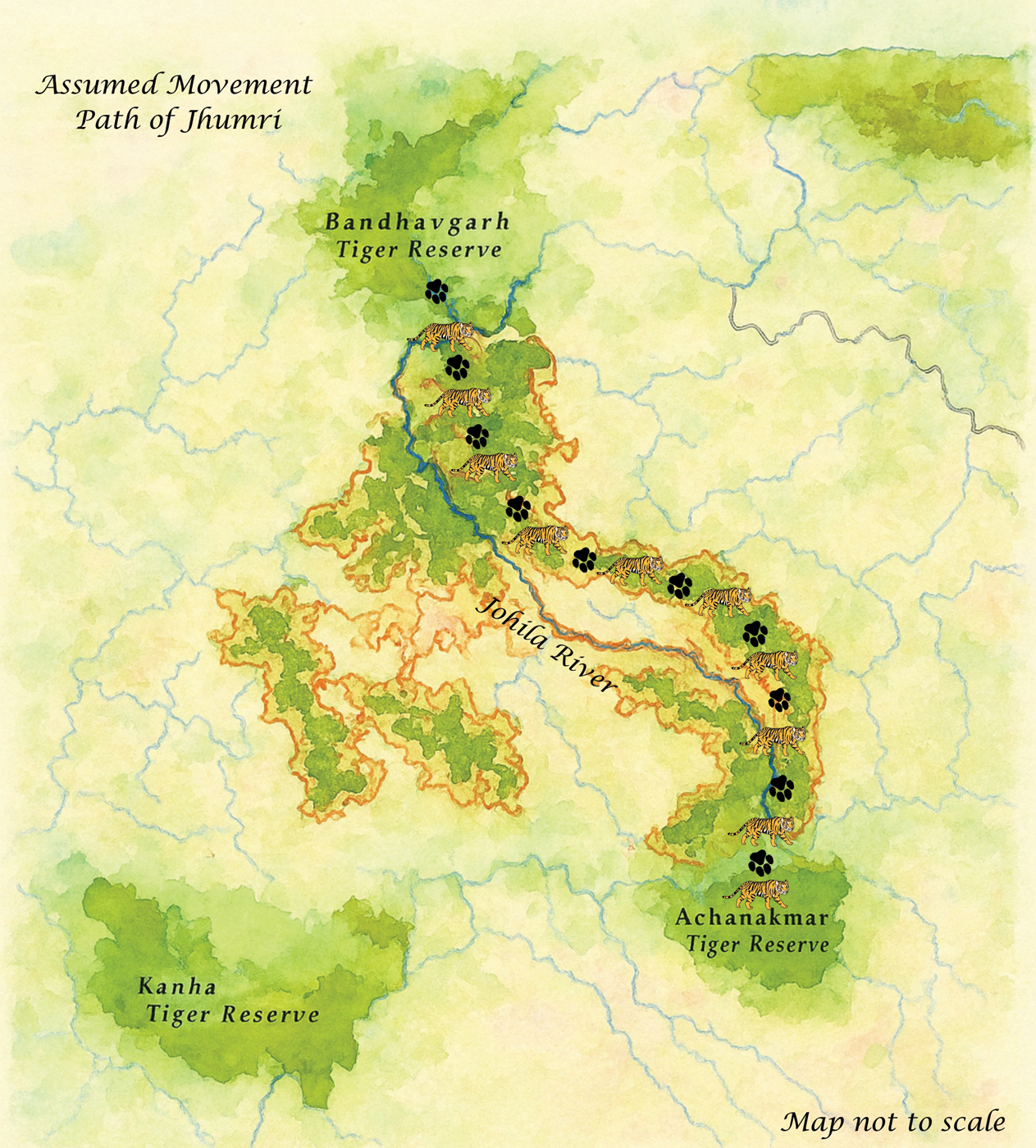The Hope-Giving Tigress Of Achanakmar
First published in Sanctuary Asia,
Vol. 45
No. 10,
October 2025
By Malvika Colvin and Sneha Tiwari
In 2016, deep within the forests of the Bandhavgarh Tiger Reserve in Madhya Pradesh, a tigress named Spotty gave birth to a female cub sired by the dominant male Mangu. This cub, later named Jhumri, would grow up to embark on an extraordinary journey – one that would span over 200 km. and cross forests, villages, and farmlands.
Jhumri was last sighted in Bandhavgarh in 2018 by WWF-India’s team. Then, in 2021, a tigress was spotted with two cubs in the Achanakmar Tiger Reserve (ATR) in Chhattisgarh. Her identity remained uncertain until 2022, when camera traps confirmed what few had imagined: it was Jhumri. She had travelled across human-dominated landscapes to establish a new territory in ATR, likely around 2020, during the stillness of the COVID-19 lockdown.
Tigers are known to travel in search of new territory, but such long-distance dispersal is rare and dangerous. After leaving Bandhavgarh, Jhumri would have encountered dense forests, followed by vast stretches of villages and farmland. Her survival depended on instinct, luck, and perhaps the guiding presence of water.

The Achanakmar Tiger Reserve in Chhattisgarh is part of the Achanakmar-Amarkantak Biosphere Reserve. Camera trap images from December 2023 recorded 10 tigers in ATR, including dispersing individuals from the Bandhavgarh and Kanha Tiger Reserves. Photo: Vishal Trehan/Sanctuary Photolibrary.
Conservationists believe she may have followed the Johila river, which rises in the Jaleshwar Mahadev region of Amarkantak. Flowing through the Manpur Range and the Ghunguti region of Umaria Forest Division, the river likely offered a natural corridor through forest patches all the way to ATR. Jhumri’s journey is not just a tale of survival – it’s a symbol of hope, underscoring the importance of wildlife corridors and the resilience of India’s tigers.
Competition And Settling In
Jhumri’s first litter in ATR had a tough time. One of her cubs was killed by a male tiger and the Chhattisgarh Forest Department therefore kept a very close watch on the mother and her remaining cub. After the cub's death, Jhumri was seen walking alongside the dominant, territorial male. Soon after, pugmarks indicated that the male had vacated his territory, moving toward agricultural fields near Kota.
In 2023, Jhumri gave birth to a second litter – a male and a female, and both cubs made it to sub-adulthood. They are often seen exploring the dense forests of ATR. Jhumri has since found another mate and had her third litter (four cubs this time!). Interestingly, this male tiger is now frequently seen with Jhumri and her cubs. It is fair to say Jhumri is a survivor; she is truly the reigning queen of ATR who has changed the reserve’s fortunes.
Sanjay Luthar, Additional Director, Core, ATR, says: “This resilient tigress has journeyed across unknown terrains, leaving behind her birthplace and carving out a territory of her own in our tiger reserve. Her successful settlement is not just a story of wildlife movement, but a testament to her unmatched adaptability, and the health of our ecosystem. She now roams confidently as the queen of our reserve! She is an emblem of hope for tiger conservation and landscape connectivity.”

In 2023, Jhumri gave birth to her second litter of two cubs, one male and one female , both of whom survived to sub-adulthood and are now often seen exploring the dense forests of the Achanakmar Tiger Reserve (ATR). Since then, Jhumri has found a new mate and had a third litter of four cubs. Remarkably, the male is frequently seen alongside her and the cubs, a rarely seen tiger behaviour. A true survivor, Jhumri has become the reigning queen of ATR, reshaping the reserve’s fortunes. Photo Courtesy: WWF-India.
Tiger Population On The Rise
The Achanakmar Tiger Reserve has shown encouraging signs of recovery in recent years. It now supports three breeding females: TK8 (Jhumri), TK16, and TK17. This is a strong indicator of a secure and protected habitat, with sufficient food and water. According to a recent report by WWF-India and the Chhattisgarh Forest Department, ‘Recovering Stripes – A Population Status of Tigers and their Prey in Achanakmar Tiger Reserve’, the Protected Area’s tiger population had stagnated at just five individuals for many years. Existing numbers remain modest, but have doubled. Camera trap images from December 2023 recorded 10 tigers, including dispersing individuals from the Bandhavgarh and Kanha Tiger Reserves. This increase demonstrates that the corridors linking ATR with surrounding landscapes are functional.
Despite this positive trend, challenges remain. Tigers currently occupy only about 50 per cent of the available habitat, underscoring the need for habitat expansion and improved prey availability. Areas such as Surahi and Lamni within ATR, for example, continue to have low ungulate densities. Radio-collaring tiger individuals to monitor their movement and habitat use could certainly provide valuable insights to guide future conservation strategies.
WWF-India, in collaboration with the Chhattisgarh Forest Department, is actively working to strengthen conservation in ATR through habitat management, improved patrolling, and enhanced surveillance for anti-poaching units. Equally important is the involvement of local communities around the reserve’s fringes, whose participation remains vital to the tiger reserve's long-term protection and coexistence.

In 2023, Jhumri gave birth to her second litter of two cubs, one male and one female , both of whom survived to sub-adulthood and are now often seen exploring the dense forests of the Achanakmar Tiger Reserve (ATR). Since then, Jhumri has found a new mate and had a third litter of four cubs. Remarkably, the male is frequently seen alongside her and the cubs, a rarely seen tiger behaviour. A true survivor, Jhumri has become the reigning queen of ATR, reshaping the reserve’s fortunes. Photo Courtesy: WWF-India.
What’s Next?
Jhumri’s story doesn’t end with her arrival in Achanakmar – it’s just the beginning. The future of ATR will likely be shaped by her survival and that of her cubs. As these young tigers grow, they’ll need to find and claim territories of their own. This natural instinct could spark competition or even push them beyond the reserve’s protective boundaries in search of territories. The challenge now lies in guaranteeing them safety and resources to thrive in their chosen territories. Their journey ahead underscores a critical truth: the future of India’s tigers depends not just on isolated reserves, but on the connectivity between them and safe corridors that allow them to move, disperse, and endure.
“Jhumri is more than a tigress for me; she is a living memory of my wildlife journey. I have known her since she was a cub, the time when she used to frolic in the Bandhavgarh Tiger Reserve with her two sisters and mother Spotty. I still remember her leaping to chase butterflies,” says Upendra Dubey, Senior Project Officer, Central India Landscape, WWF-India.
The Central Indian Protected Areas such as Kanha, Pench, Sanjay, Bandhavgarh, and Achanakmar, are well connected through corridors, and in recent years, we have seen encouraging evidence of the dispersal of large mammals, including tigers and elephants. These corridors are not only stretches of forest but also a mosaic of agriculture, settlements, and woodlands. Rapid land-use changes for irrigation, highways, railways, dams, mining, and development are, unfortunately, pushing them to the brink, bringing challenges such as human-wildlife conflict and hindering animal migration.

Illustration of the assumed path that Jhumri took to reach the Achanakmar Tiger Reserve. Photo Courtesy: WWF-India.
Recent Long Migrations by Tigers
. T1C1 (The Walker): The Walker is a radio-collared male tiger who undertook the longest recorded journey by a tiger, travelling nearly 3,000 km. in 2020-21. He started from the Tipeshwar Wildlife Sanctuary in Maharashtra and moved through seven districts across Madhya Pradesh and Telangana before finally settling in Maharashtra’s Dnyanganga Wildlife Sanctuary.
. The Walker 2: This male tiger made an equally remarkable journey of about 1,500 to 2,000 km., from 2020 to 2021. He began from Tipeshwar, moved to Pandharkawda in Vidarbha’s Yavatmal district, then travelled into Telangana before looping back into Maharashtra. His route took him through Akola, Buldhana, and Hingoli districts of Maharashtra before finally reaching Aurangabad’s Gautala Autramghat Sanctuary in the Ajanta mountain ranges.
. Tiger NT1: This male tiger travelled close to 300 km. in Madhya Pradesh, starting from Mahu in Indore and moving to Raisen district near Bhopal in 2023-24. The Forest Department later relocated him to the Satpura Tiger Reserve, and eventually he was shifted again to Van Vihar National Park in Bhopal.
. T-14: This tigress dispersed from the Pench Tiger Reserve in Maharashtra and made a long journey to the Achanakmar Tiger Reserve in Chhattisgarh. She finally settled there during 2024-25, marking a significant female dispersal event in the region.
. Zeenat: In November 2024, this tigress was relocated from the Tadoba-Andhari Tiger Reserve, Maharashtra to the Simlipal Tiger Reserve in Odisha. However, in December 2024, she set off on an extraordinary journey, moving across three states in just 21 days and covering over 300 km. From Odisha she entered Jharkhand, where she spent about a week, before travelling further into West Bengal through Jhargram, Bandana in Purulia district, and finally reaching Manbazar.
“Stories such as the journey of tigress Jhumri highlight that the corridors are still alive, offering hope and underscoring the urgent need for their conservation,” says Sandeep Chouksey, Associate Coordinator, Central India Landscape, WWF-India.
Jhumri is showing us the path ahead – may we let that path remain wild.
Malvika Colvin was previously with WWF-India. She is a biodiversity specialist who finds purpose in the wild, dedicating her work to protecting tigers, vultures, and the forests they call home. Sneha Tiwari handles policy and communications for the Central Indian landscape in WWF-India. With a background in Public Administration and Policy, her work lies at the intersection of conservation, community narratives, and communication.





